Do you know the stick beard (Tillandsia usneoides)?... Is it a plant or a parasite?... // Conoces la barba de palo(Tillandsia usneoides)?... Es una planta o un parásito?...[ENG-ESP]
Hello dear community as usual this is an open space for all of us who get plants, animals and other living things that amaze. And if we look for something in nature that does not call the attention, it is little what we get because everything is part of an ecosystem of perfect balance. For example plants, in their diversity of species we find from the smallest with their unique aroma, size and shape, to the largest, with details that identify only them. That's why every type of plant I see catches my attention, but this stick beard, also known as old man's beard or hay (Tillandsia usneoides), is a plant that now is that I come to know "that it is actually a plant", hahaha. In the town where mom was born it was very common to see them hanging from almost every tree and power line in town. We even came to think that they were a type of parasite that invades the tree until it takes away its nutrients and kills it. I came to the conclusion that the bearded woodwort kills the trees because I often saw trees without any leaves or flowers, only with this plant on their branches.
Hola querida comunidad como es costumbre este es un espacio abierto para todos los que conseguimos plantas, animales y demás seres vivos que asombran. Y si buscamos en la naturaleza algo que no llame la atención, es poco lo que conseguimos pues todo forma parte de un ecosistema de equilibrio perfecto. Por ejemplo las plantas, en su diversidad de especies encontramos desde las más pequeñas con su aroma, tamaño y forma únicos, hasta las más grandes, con detalles que las identifica solo a ellas. Por eso me llama la atención cada tipo de plantas que veo, pero está barba de palo, también conocida como barba de viejo o heno(Tillandsia usneoides),es una planta que ahora es que vengo a saber "que en realidad es una planta", jajaja. En el pueblo donde nació mamá era muy común verlas colgando de casi todos los árboles y tendidos eléctricos del pueblo. Incluso llegamos a pensar que eran un tipo de parásito que va invadiendo el árbol hasta quitarle los nutrientes y acabar con el. Está conclusión de que la barba de palo acaba con los árboles la saqué por qué vi con frecuencia árboles sin ninguna hoja o flor, solo con esta planta en sus ramas. Foto árbol pelado sin hojas solo con la barba.)
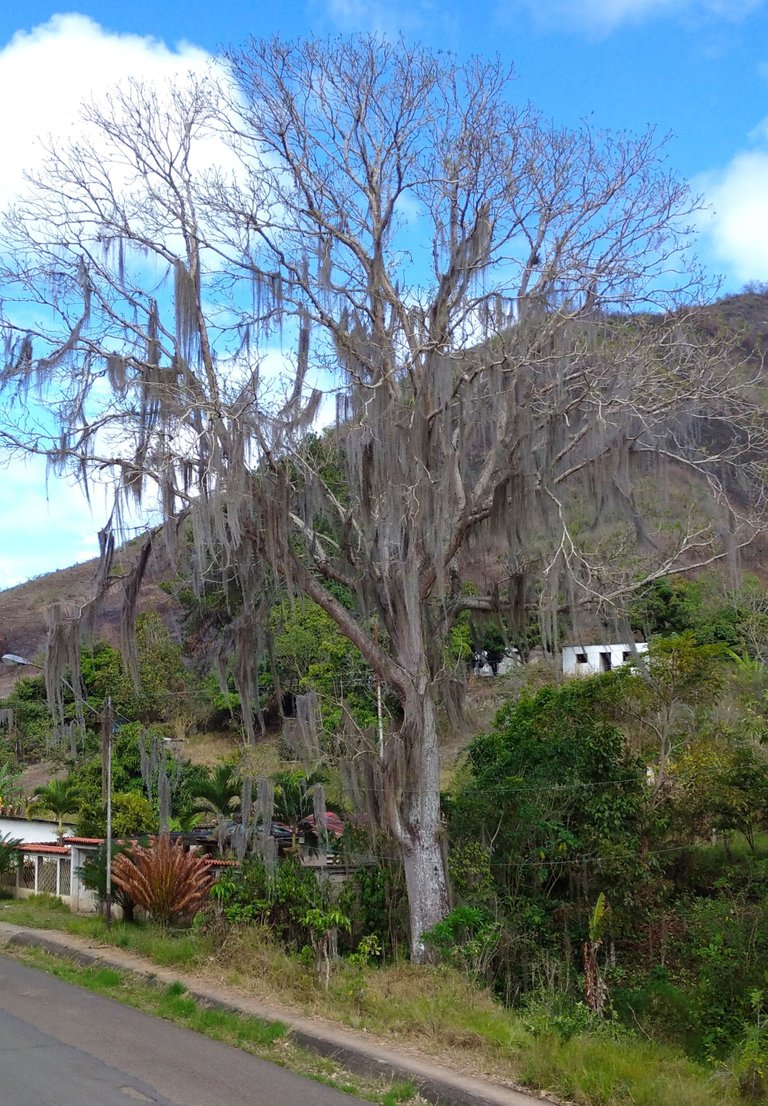
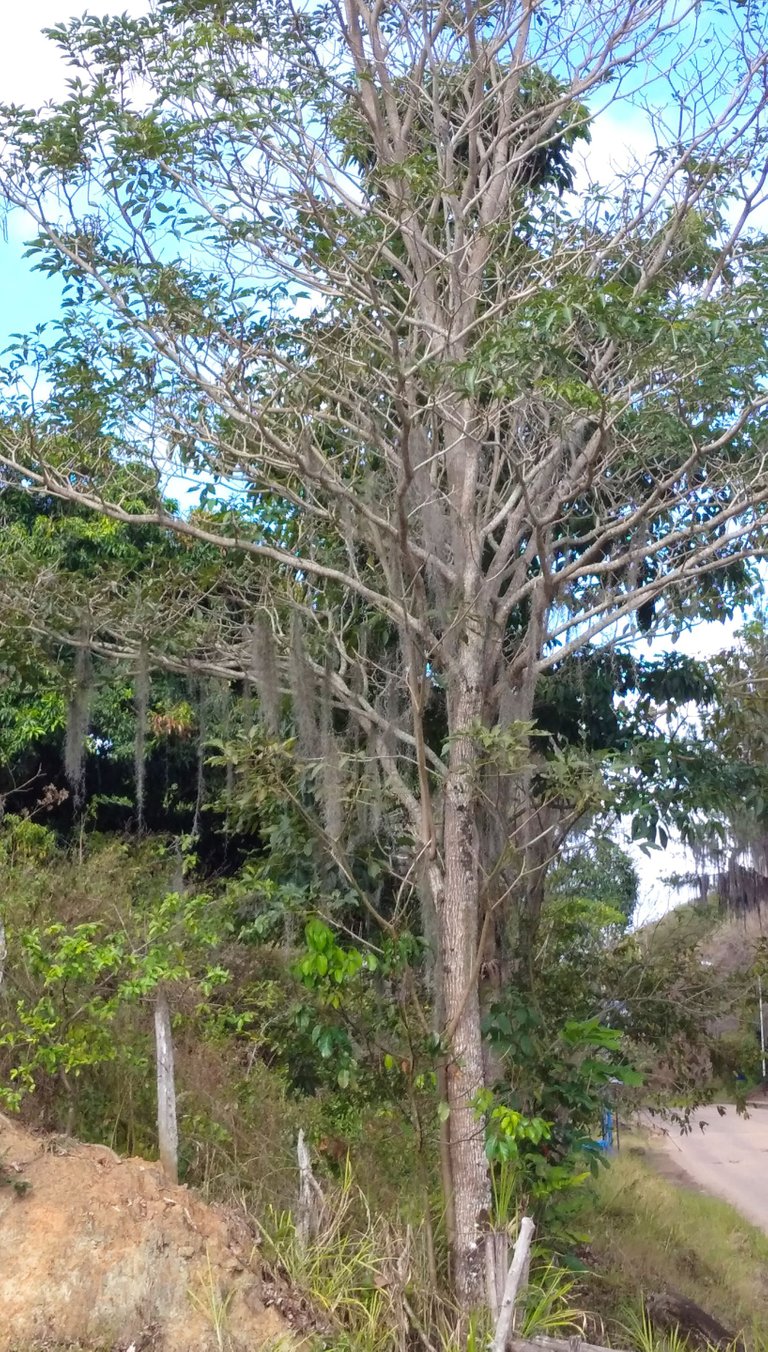

Well, now I realize that this plant is a type of bromeliad, did you know that? Yes. Although it almost always lives on top of the trees it is not a parasite, it does not do any harm to them.the Tillandsia usneoides or barba de palo, known by that name in Venezuela, absorbs nutrients (especially calcium) and water, from the air and from the humidity produced by the rains. Even the area where Mama lives is very humid, enclosed by mountains and therefore there is always mist and drizzle typical of the site, and also with frequent summer periods, this forms a special environment for this plant. It is colloquially known as "air plant", so it does not need the tree or the plant where it is born to survive, because it takes from the air and humidity what it needs, incredible isn't it..... But I never imagined that it was a living plant, because I have never seen flowers or a green color, no, it is gray, and even some of its branches are light brown, it seems that in reality it is dry, lifeless. But it is not like that, in some places of the planet it does bloom although they are isolated cases.
How does this beard of stick to be born in the highest of the trees?...Each plant produces enough seeds that spread from one side to another because the wind does its part, carries it and lodges it where one least thinks, roofs of some houses, dry trunks, large and small trees. Birds also use it to make their nests and it is responsible for part of the propagation of the seed and proliferation of this plant. A nest made with this plant must be very cozy because if we see it taking one of its threads, it looks rough and strong, but if there are several threads joined together, it is possible that it generates warmth and comfort to the chicks. In front of mom's house a tree fell down due to heavy rains and it was full of stick beards. So I went over and was able to take a sample and photograph it up close, otherwise it is not possible. Every strand of this plant seems unbreakable, hahaha, and its smell is just like old wood with some humidity, because it lives up to the name it is known by...old man's beard, hahaha. When I put several together it looks cozy for the little animals to nest in.
Pues ahora me doy cuenta que esta planta es un tipo de bromelia, lo sabían?... Si. Aunque casi siempre vida encima de los árboles no es un parásito, ella no le hace ningún daño. La Tillandsia usneoides o barba de palo, conocida con ese nombre en Venezuela, absorbe nutrientes (especialmente calcio) y agua, del aire y de la humedad que producen las lluvias. Incluso la zona donde vive mamá es muy humedad, cerrada con montañas y por eso siempre se ve neblina y lloviznas propias del sitio, y también con épocas frecuentes de verano, esto forma un ambiente especial para esta planta.. Se la conoce coloquialmente como "planta del aire", por eso ella no necesita del árbol o la planta dónde nace para sobrevivir, pues toma del aire y la humedad lo que necesita, increíble no?... Pero es que nunca me imaginé que fuera una planta, viva, pues nunca le he visto flores o de un color verde, no, ella es de color gris, y hasta algunas de sus ramas son marrón claro, que pareciera que en realidad está seca, sin vida. Pero no es así, en algunos sitios del planeta si florece aunque son casos aislados.
Cómo hace está barba de palo para nacer en lo más encumbrado de los árboles?...Cada planta produce suficiente semillas que se propagan de un lado a otro por qué el viento hace su parte, la lleva y aloja en dónde menos uno piensa, techos de algunas casas, troncos secos, árboles grandes y pequeños. También las aves la usan para hacer sus nido y ella son responsables de parte de la propagación de la semilla y proliferación de esta planta. Y es que debe ser muy acogedor un nido hecho con esta planta pues si la vemos tomando uno de sus hilos, se ve áspera y fuerte, pero si hay varios hilos unidos, es posible que genere calor y comodidad a los polluelos. En el frente de la casa de mamá un árbol se cayó debido a las fuertes lluvias y estaba lleno de barbas de palo. Por eso me acerque y pude tomar una muestra y fotografiarla de cerca, pues de otro modo no es posible. Cada hilo de esta planta parece irrompible, jajaja, y su olor es justo a madera vieja con algo de humedad, pues le hace honor al nombre con que se le conoce...barba de viejo, jajaja. Cuando junto varias se ve acogedor para los animalitos anidar.

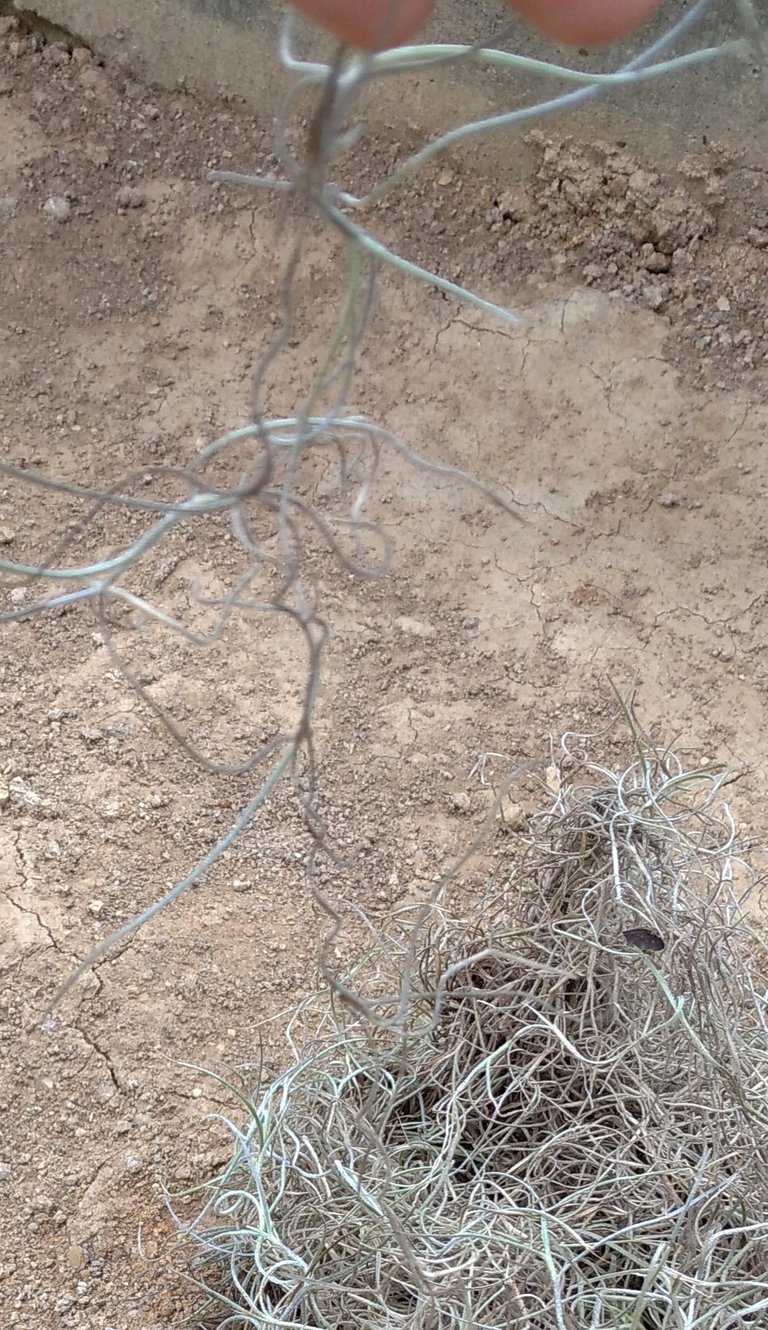
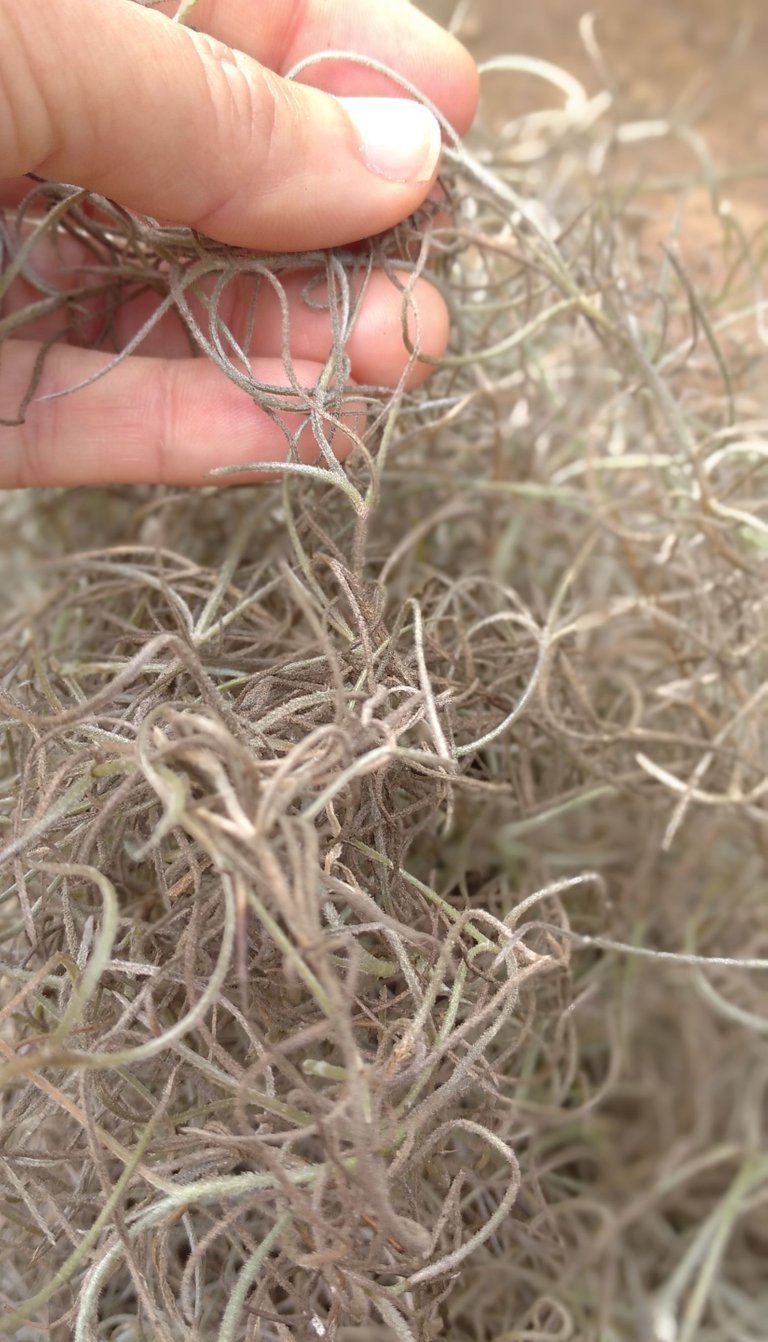
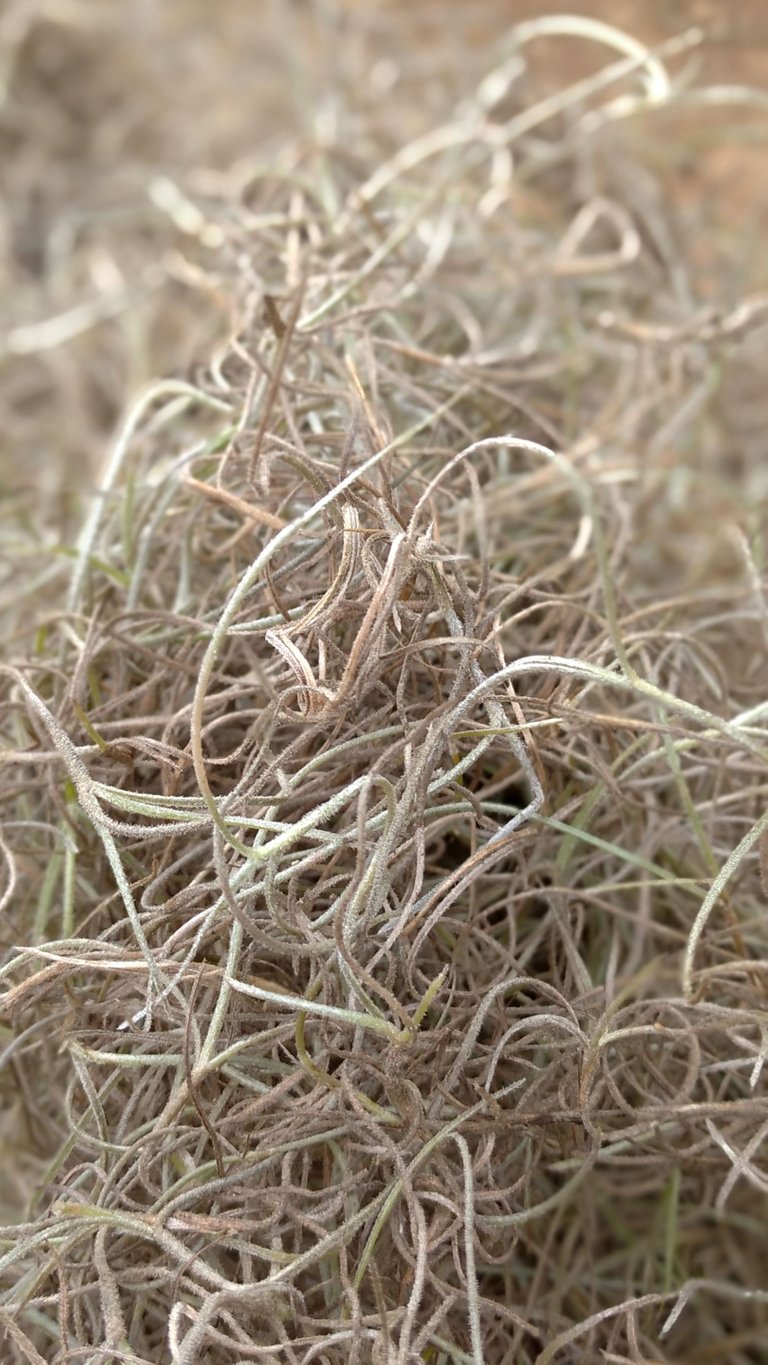

It is customary for people to use this stick beard to make arrangements and decorations in their homes or gardens, because as I told you it is strong but has its unique appeal. That is why some organizations that try to preserve the species of nature such as this plant, have fought so that it is not commercialized in such a way that it disappears. It is so picturesque to arrive at the village and see the trees dressed with this beard, which is in my childhood memories and even now that I see them are part of the ecosystem of the area, I can not imagine them without them hanging. When I observe their beauty together with the guests where they stay, I can only admire them. In the case of the hosts where it develops, it only deprives them of the sun's rays, because they absorb almost everything and it is possible that this affects the plant or tree in its growth, but they never cause its death. Sometimes there are even so many stick beards accumulated in a single tree that they seem to be the leaves of the tree. The elongated shape of their leaves and their multitude together can easily adorn the host, as they look like extensions of the branches of the same tree that hang down.
Es costumbre que las personas usan está barba de palo para hacer arreglos y decoraciones en sus casas o jardines, pues como ya les dije ella es fuerte pero tiene su atractivo único. Por eso algunos organismos que procuran preservar las especies de la naturaleza como esta planta, han luchado para que no se comercialice a tal modo que llegue a desaparecer. Es tan pintoresco llegar al pueblo y ver vestido a los árboles con está barba, que está en mis recuerdos de infancia y aún ahora que las veo forman parte del ecosistema de la zona, no me los imagino sin ellas colgando. Cuando observo su belleza junto a los huéspedes dónde se aloja no me queda más que admirar. En el caso de los huéspedes dónde se desarrolla, solo los priva de los rayos del sol, pues ellas lo absorben casi todo y es posible que esto afecte la planta o árbol en su crecimiento, pero nunca llegan a causar su muerte. Incluso a veces se acumulan tantas barbas de palo en un solo árbol que parecieran que ellas fueran las hojas de este. La forma alargada de sus hojas y su multitud juntas pueden adornar fácilmente al huésped, pues parecen extensiones de las ramas del mismo árbol que cuelgan.
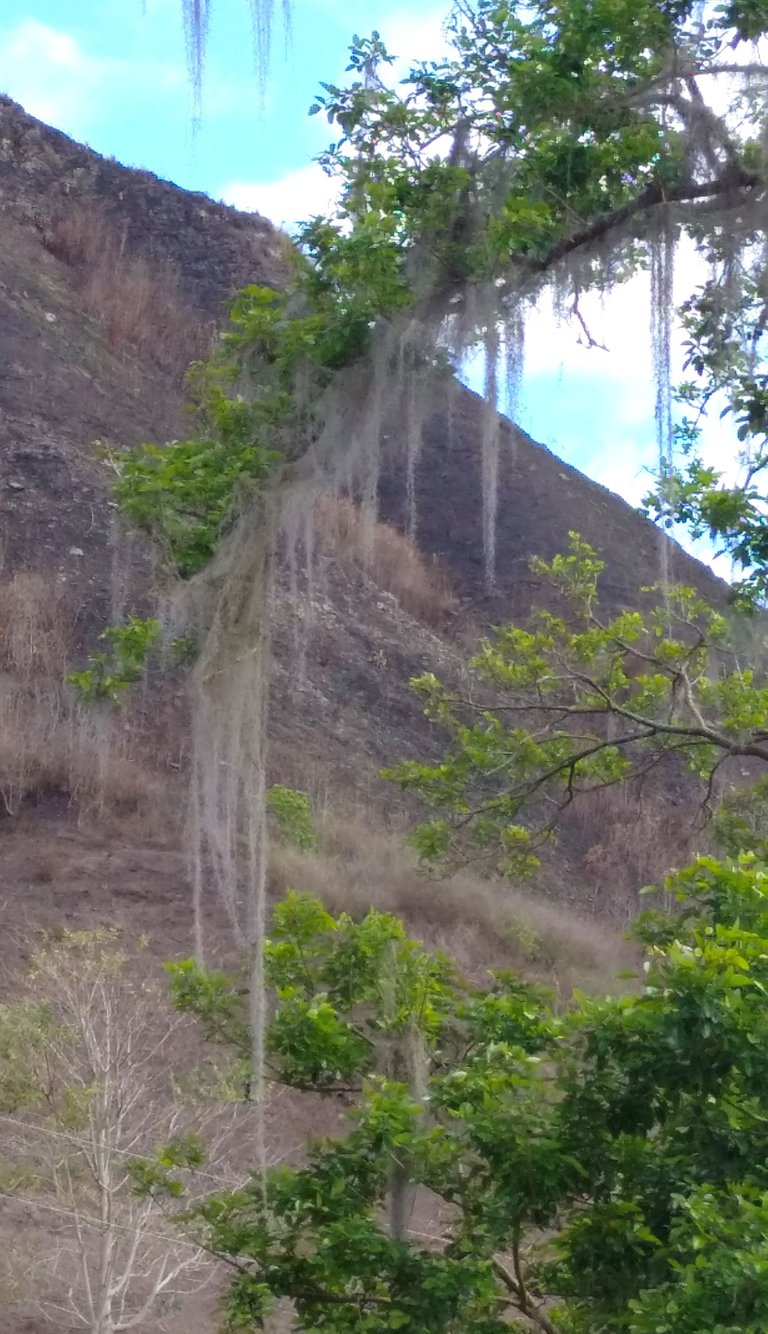
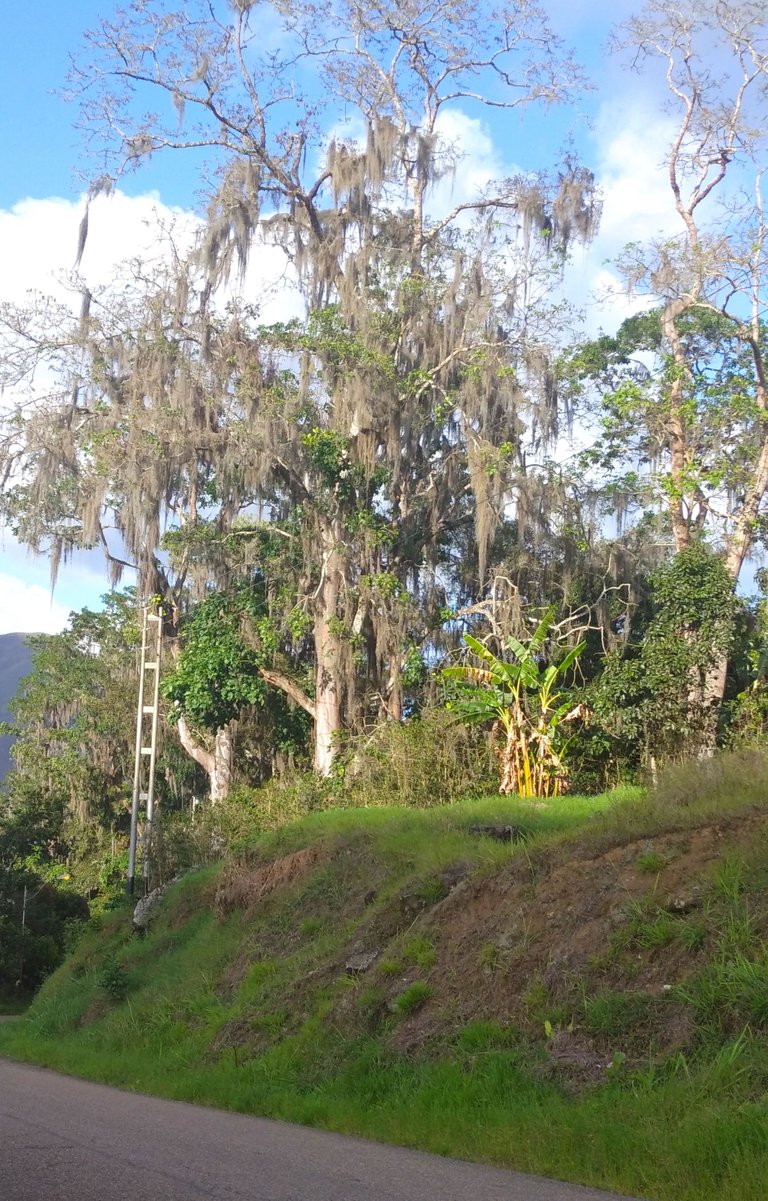

It is also possible to plant them, is a way of saying it, hahaha, because they do not have roots to put it in the ground and develop, but it can be grown at home. If you have the given conditions inside the house or in a place where there is humidity and at the same time that in day has enough hours in which it receives the rays of the sun, warm environment, it can be maintained without problem. The only thing is that if it blooms, its flowers are tiny. For the rest, it will only be its opaque color, or at least the ones I know in this area. You can see that in other places like Spain, its color varies because there are not only gray or brown but in green colors and even bloom. They are grown in houses and are also used to decorate gardens, but as what is a plant, a living being. Only that care must be taken, because it always carries its seeds, abundant that make them proliferate in quantity.
After all, it is not easy to see it as a living being, that's why this barbarian is so amazing, like other plants, it needs sun, water and a host to be able to develop. And if it likes to develop in the heights at the top of the trees, making a kind of clothing to the branches of entire trees. Another detail is that from the shape and accumulation of the stick beard, it can be a nest not only for birds but also for some snakes, because they hide there to be warm when they need it. That is why you have to be careful when you are collecting its leaves in case you have any other animal hiding there. Some even give it medicinal use as any other plant that surely offers its benefits, but in the place where mom lives is not well known that use, so I do not know them.
También es posible sembrarlas, es una forma de decirlo, jajaja, pues ellas no tienen raíces como para ponerla en tierra y que se desarrolle, pero se puede cultivar en casa. Si se tiene las condiciones dadas dentro de la casa o en un sitio donde haya humedad y a la vez que en día tenga suficientes horas en que reciba los rayos del sol, ambiente tibio, puede mantenerse sin problema. Lo único es que si acaso florece, sus flores son pequeñitas. Del resto, solo será su color opaco, o al menos las que yo conozco en esta zona. Puede ver qué en otros sitios como España, su color varía pues hay no solo grises o marrones sino en colores verdes y hasta florecen. Las cultivan en casas y las usan también para adornar en jardines, pero como lo que es una planta, un ser vivo. Solo que debe tenerse cuidado, pues ella siempre lleva sus semillas, abundantes que hacen que se proliferen en cantidad.
Después de todo, no es fácil verla así como un ser vivo, por eso lo increíble de esta bárbara de palo, al igual que otras plantas necesita del sol, agua y de un huésped para poder desarrollarse. Y si que le gusta desarrollarse en las alturas en lo más alto de los árboles, haciendo como especie de ropa a las ramas de árboles enteros. Otro detalle es que de la forma y acumulación de la barba de palo, puede ser nido no solo para aves sino también para algunas serpientes, pues se esconden allí para estar calientes cuando lo necesitan. Por eso hay que tener cuidado cuando se esté recogiendo sus hojas por si tiene algún otro animal allí escondido. Incluso algunos le dan uso medicinal como cualquier otra planta que de seguro ofrece sus beneficios, pero en el lugar donde vive mamá no es muy conocido ese uso, por eso no los conozco.
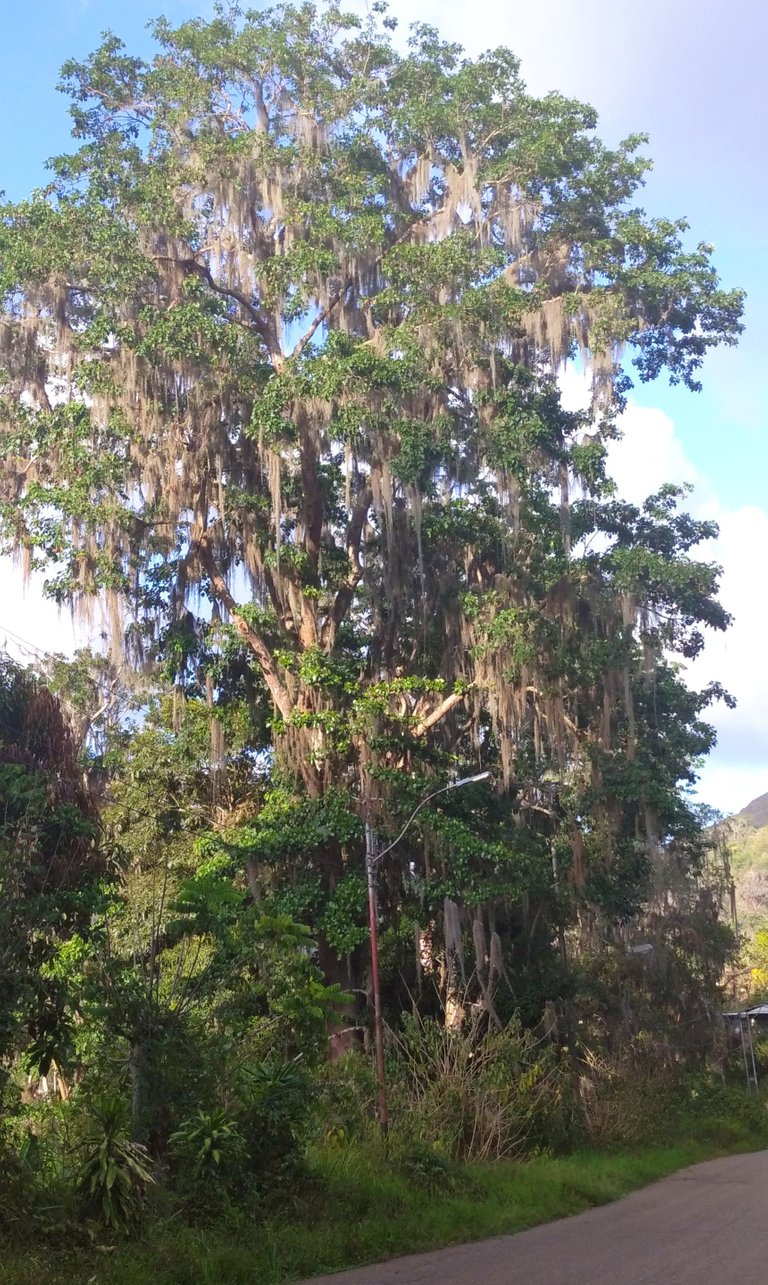
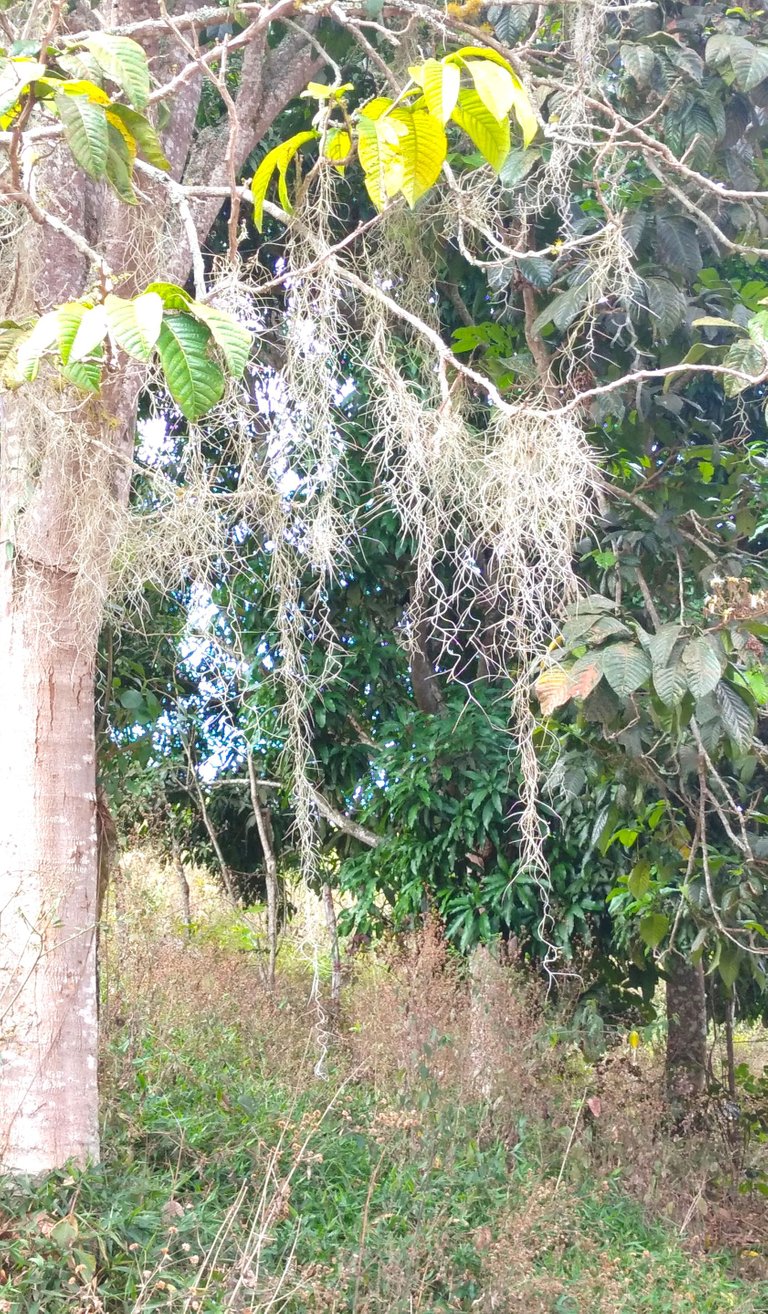
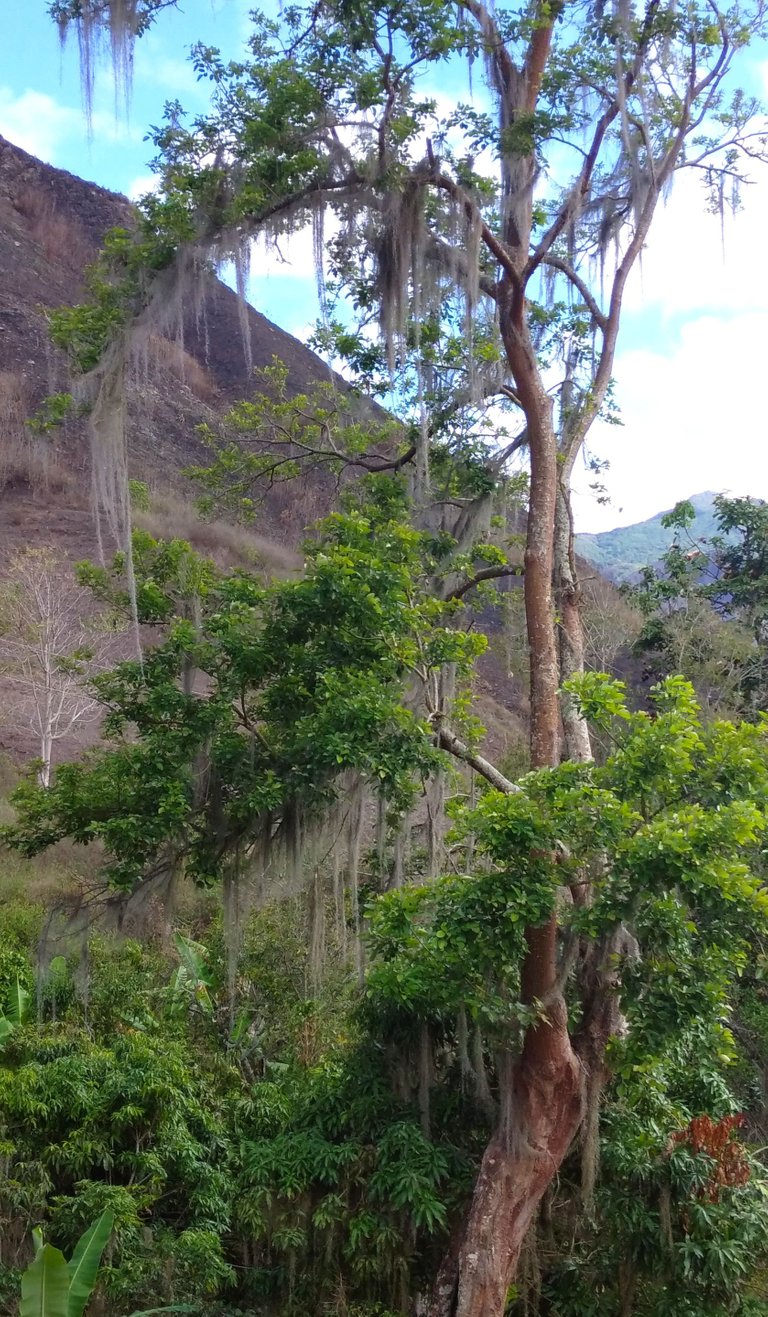

In the case of this plant barba de palo or barba de viejo, there is not much delight for some in cultivating it, less in knowing it, because it is difficult to access and also the reality is that what most attracts the attention of growing a plant is the beauty of its leaves, its color or its flowers. This is not the case of this plant and yet it has its uses and its peculiar and amazing way of living and developing like any other. Now I have a lot to tell the new children growing up in this mountainous area, so that when they see this old man's beard hanging, they will know that it is a plant, not a parasite, and that it survives in its own way on top of the trees. Also in the schools it is common that the teachers from time to time send to pick some of these plants to decorate the school garden or the classrooms because due to its color it is easy to combine with any other flowering plant.
En el caso de esta planta barba de palo o barba de viejo, no hay mucho deleite para algunos en cultivarla, menos en conocerla, pues es de difícil acceso y además que la realidad es que lo que más llama la atención de cultivar una planta es la hermosura de sus hojas, su color o sus flores. Este no es el caso de esta planta y sin embargo tiene sus usos y su manera peculiar y asombrosa de vivir y desarrollarse como cualquier otra. Ahora tengo mucho que contarle a los nuevos niños que van creciendo en esta zona de montañas, para que cuando vean colgar estás barba de viejo, sepan en realidad que es una planta, no un parásito y que sobrevive a su manera encima de los árboles. También en las escuelas es común que los maestros de vez en cuando manden a recoger algunas de estas plantas para decorar el jardín del colegio o lo salones de clases por qué debido a su color es fácil de combinar con cualquier otra planta de flores.

After this, it is logical to think that everything we see in nature has an origin and a reason for being there. There are amazing diversities of plants that make up a whole universe of created species. Again...all these plants have a designer and creator and that is God. What a privilege to be able to know each one of these species as is the case of the stick beard, as well as others, that have something peculiar that identifies them as unique living beings. The photos are my property. I hope to be able to contribute in a next time, something more about our incredible nature.
Después de esto, es lógico pensar que cada cosa que vemos en la naturaleza tiene un origen y un porqué de estar allí. Hay asombrosas diversidades de plantas que conforman todo un universo de especies creadas. De nuevo...todas estas plantas tienen un diseñador y creador y ese es Dios. Que privilegio poder conocer cada una de estas especies como es el caso de la barba de palo, así como otras, que tienen algo peculiar que las identifica como seres vivos únicos. Las fotos son de mi propiedad. Espero poder aportar en una próxima vez, algo mas sobre nuestra increíble naturaleza.
Source of reference: // Fuente de consulta:
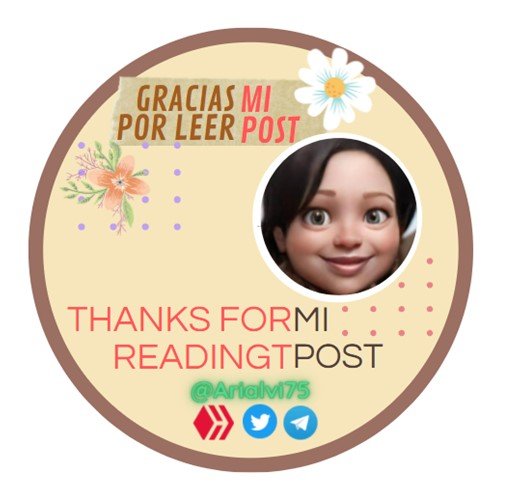
Banner made with canva.com //Banner realizado con canva.com
Separator:** Separadores de texto para Blog
I was impressed with your post. this is an amazing tree and your writing is so clear.
Gracias.Hola @arialvi75 me gustó tu publicación, muy completa, pensaba que la barba de palo era un parásito, además, ahora veo conveniente revisar antes de agarrarlo.